Differential Lexus GX470 2007 Instrument cluster / LEXUS 2007 GX470 OWNER'S MANUAL (OM60C64U)
[x] Cancel search | Manufacturer: LEXUS, Model Year: 2007, Model line: GX470, Model: Lexus GX470 2007Pages: 436, PDF Size: 11.52 MB
Page 15 of 436
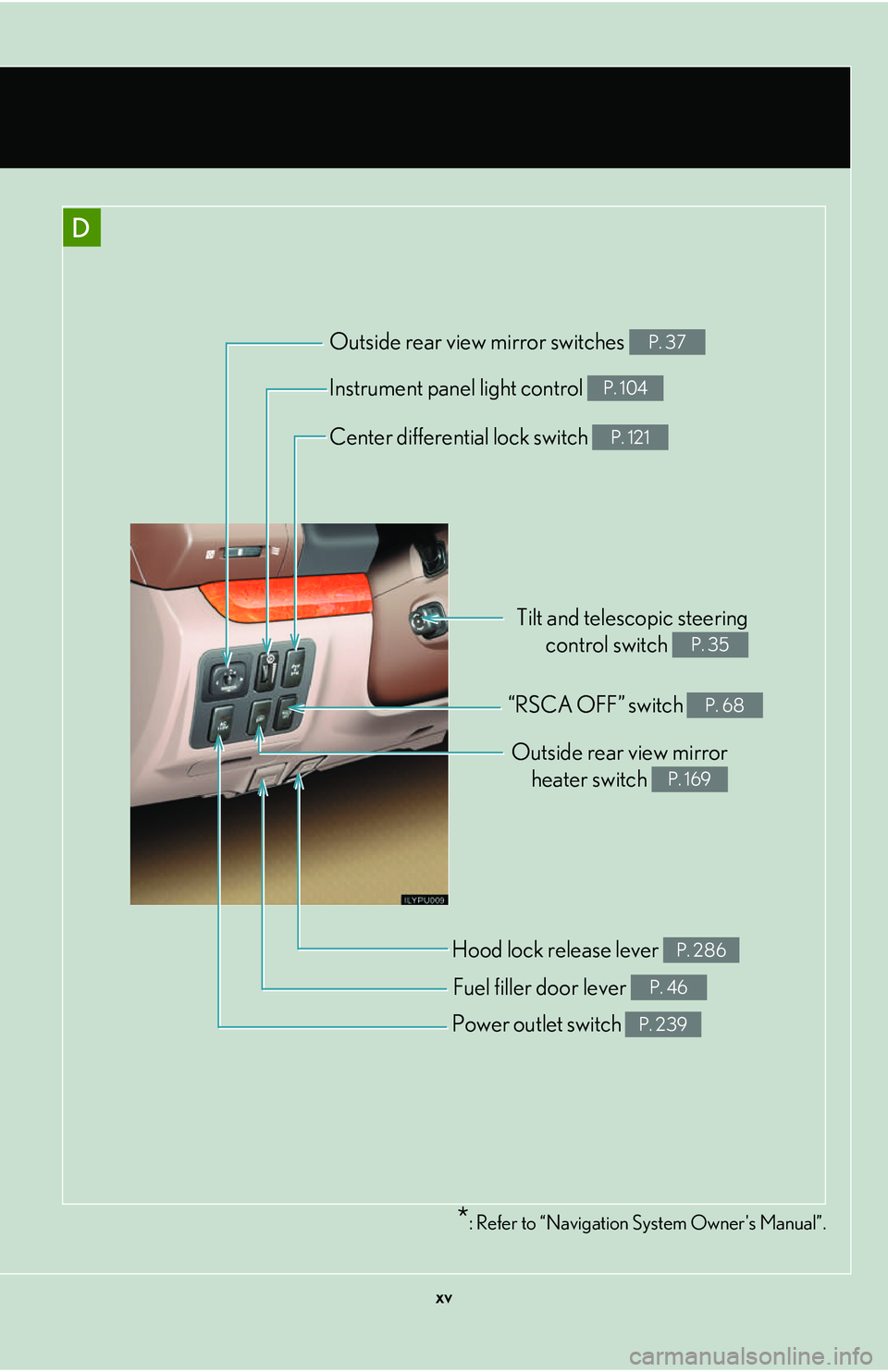
xv
D
*: Refer to “Navigation System Owner's Manual”.
“RSCA OFF” switch P. 68
Outside rear view mirrorheater switch
P. 169
Hood lock release lever P. 286
Fuel filler door lever P. 46
Power outlet switch P. 239
Outside rear view mirror switches P. 37
Instrument panel light control P. 104
Center differential lock switch P. 121
Tilt and telescopic steering control switch
P. 35
Page 126 of 436
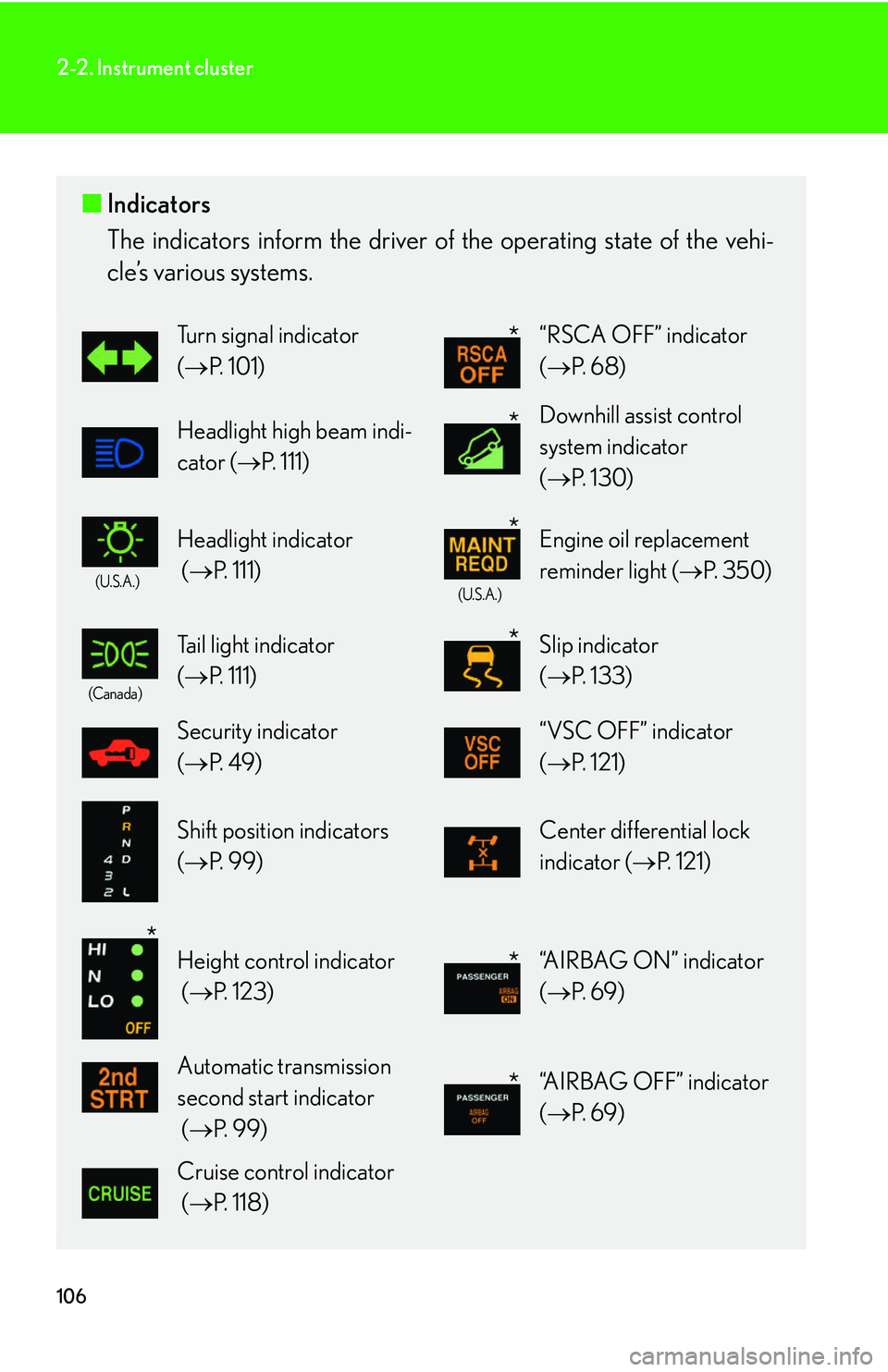
106
2-2. Instrument cluster
■Indicators
The indicators inform the driver of th e operating state of the vehi-
cle’s various systems.
Turn signal indicator
( P. 1 0 1 )“RSCA OFF” indicator
(P. 6 8 )
Headlight high beam indi-
cator ( P. 111)Downhill assist control
system indicator
( P. 1 3 0 )
(U.S.A.)
Headlight indicator
( P. 111)
(U.S.A.)
Engine oil replacement
reminder light ( P. 3 5 0 )
(Canada)
Tail light indicator
( P. 111) Slip indicator
(P. 1 3 3 )
Security indicator
(P. 4 9 ) “VSC OFF” indicator
(P. 121)
Shift position indicators
(P. 99)Center differential lock
indicator ( P. 121)
Height control indicator
( P. 1 2 3 ) “AIRBAG ON” indicator
( P. 6 9 )
Automatic transmission
second start indicator
( P. 99)“AIRBAG OFF” indicator
( P. 6 9 )
Cruise control indicator
( P. 118)
*
*
*
*
*
*
*
Page 141 of 436

121
2-4. Using other driving systems
2
When driving
Four-wheel drive system
■The four-wheel drive control lever can be operated when
●The ignition switch is in the “ON” position,
●The shift lever is in the “N” position, and
●The vehicle is stopped completely.
Use the four-wheel drive control lever and center differential lock button
to select following transfer and center differential modes.
Four-wheel drive control lever“L” (low speed position)
Driving requiring maximum
power and traction such as
climbing or descending steep
hills, off-road driving and hard
pulling in sand or mud.
“N” (neutral position)
No power is delivered to the
wheels.
“H” (high speed position)
Normal driving on all types of
roads.
Center differential lock/unlock buttonUse this button when your vehi-
cle’s wheel gets stuck in a ditch
or when you are driving on a
loose or bumpy surface.
Page 142 of 436
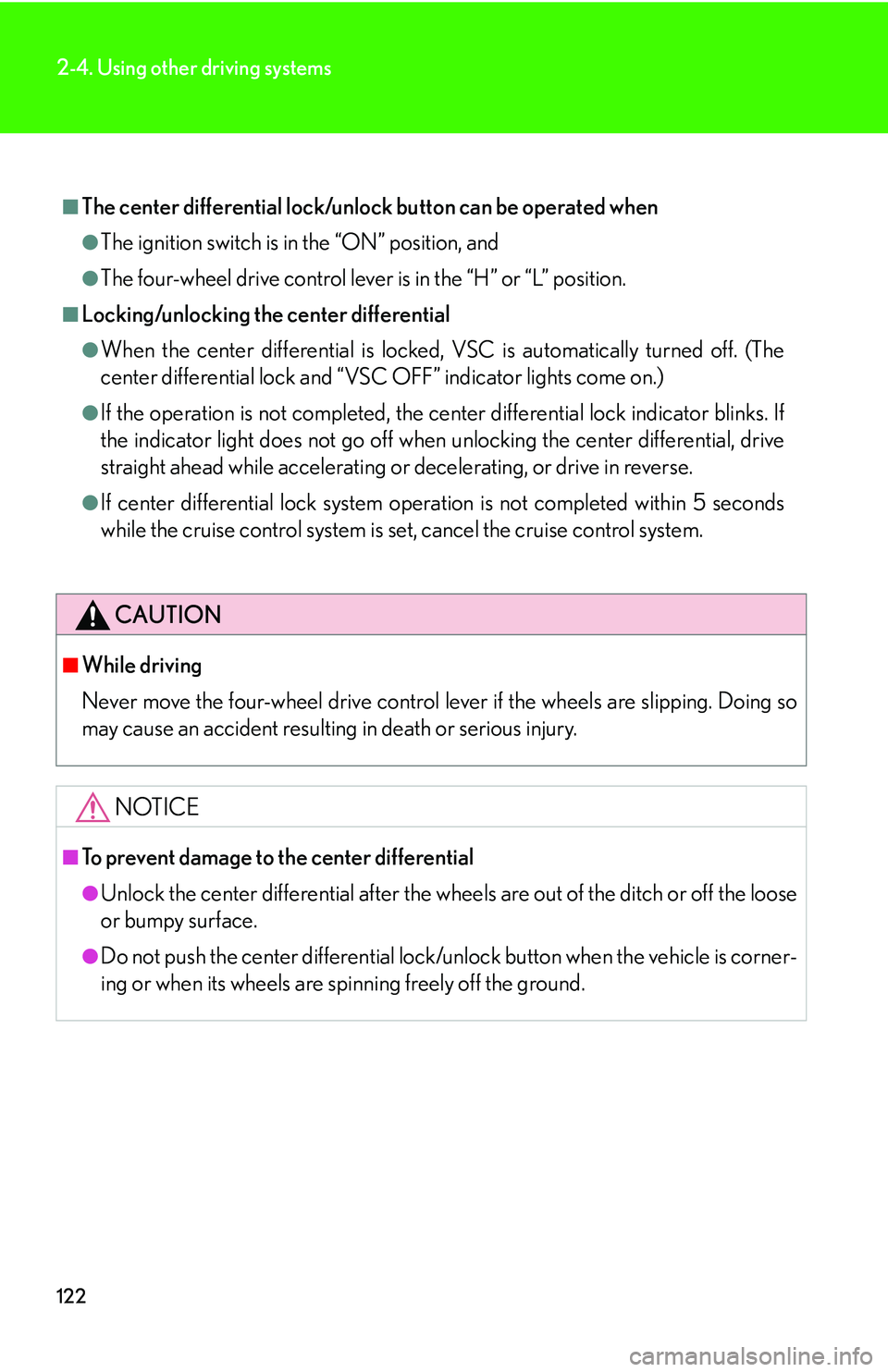
122
2-4. Using other driving systems
■The center differential lock/unlock button can be operated when
●The ignition switch is in the “ON” position, and
●The four-wheel drive control lever is in the “H” or “L” position.
■Locking/unlocking the center differential
●When the center differential is locked, VSC is automatically turned off. (The
center differential lock and “VSC OFF” indicator lights come on.)
●If the operation is not completed, the center differential lock indicator blinks. If
the indicator light does not go off when unlocking the center differential, drive
straight ahead while accelerating or decelerating, or drive in reverse.
●If center differential lock system oper ation is not completed within 5 seconds
while the cruise control system is set, cancel the cruise control system.
CAUTION
■While driving
Never move the four-wheel drive control lever if the wheels are slipping. Doing so
may cause an accident resulting in death or serious injury.
NOTICE
■To prevent damage to the center differential
●Unlock the center differential after the wh eels are out of the ditch or off the loose
or bumpy surface.
●Do not push the center differential lock/u nlock button when the vehicle is corner-
ing or when its wheels are spin ning freely off the ground.
Page 152 of 436
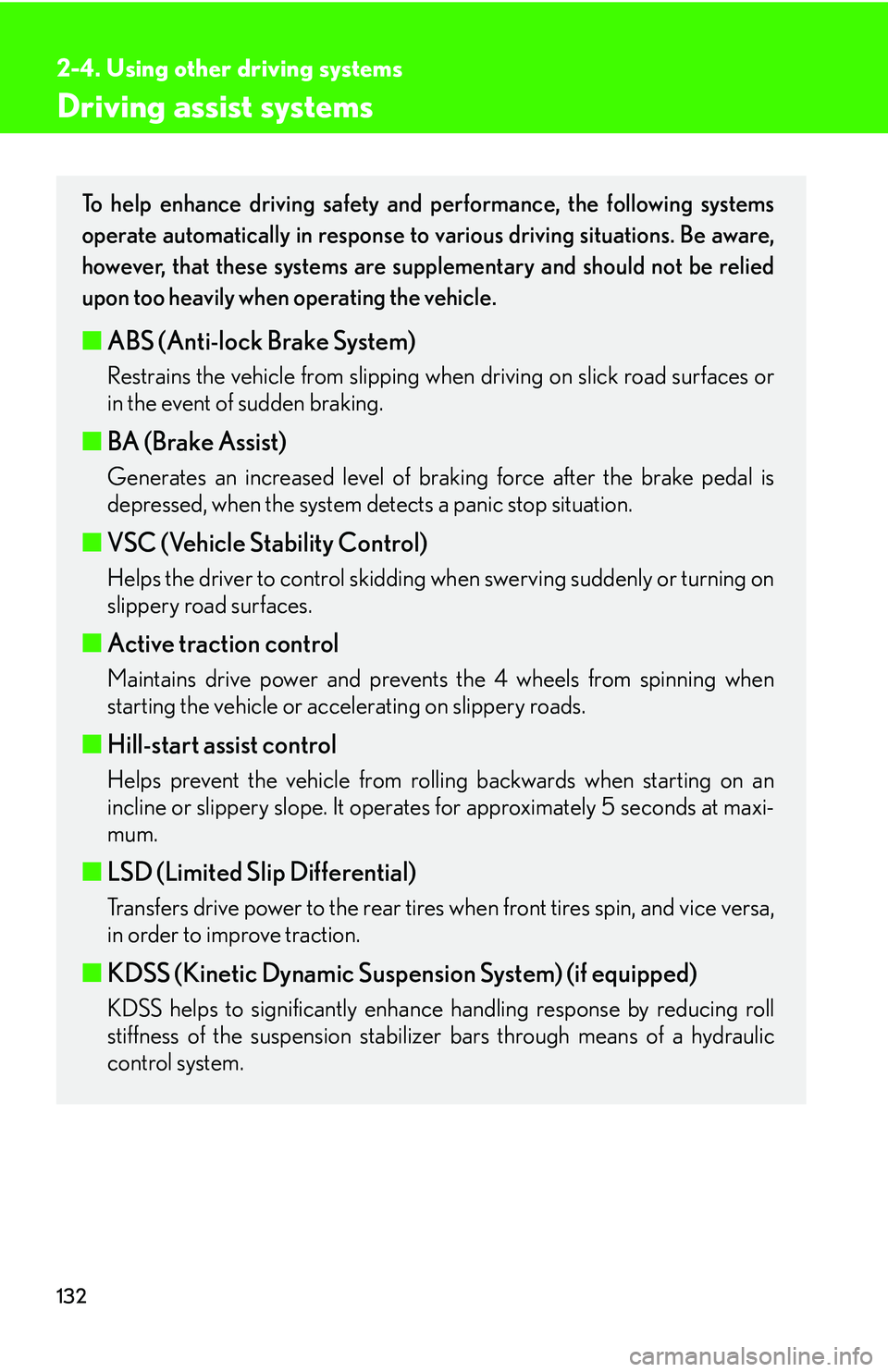
132
2-4. Using other driving systems
Driving assist systems
To help enhance driving safety and performance, the following systems
operate automatically in response to various driving situations. Be aware,
however, that these systems are supplementary and should not be relied
upon too heavily when operating the vehicle.
■ABS (Anti-lock Brake System)
Restrains the vehicle from slipping when driving on slick road surfaces or
in the event of sudden braking.
■BA (Brake Assist)
Generates an increased level of braking force after the brake pedal is
depressed, when the system detects a panic stop situation.
■VSC (Vehicle Stability Control)
Helps the driver to control skidding when swerving suddenly or turning on
slippery road surfaces.
■ Active traction control
Maintains drive power and prevents the 4 wheels from spinning when
starting the vehicle or accelerating on slippery roads.
■Hill-start assist control
Helps prevent the vehicle from rolling backwards when starting on an
incline or slippery slope. It operates for approximately 5 seconds at maxi-
mum.
■ LSD (Limited Slip Differential)
Transfers drive power to the rear tires when front tires spin, and vice versa,
in order to improve traction.
■KDSS (Kinetic Dynamic Suspension System) (if equipped)
KDSS helps to significantly enhance handling response by reducing roll
stiffness of the suspension stabilizer bars through means of a hydraulic
control system.
Page 158 of 436
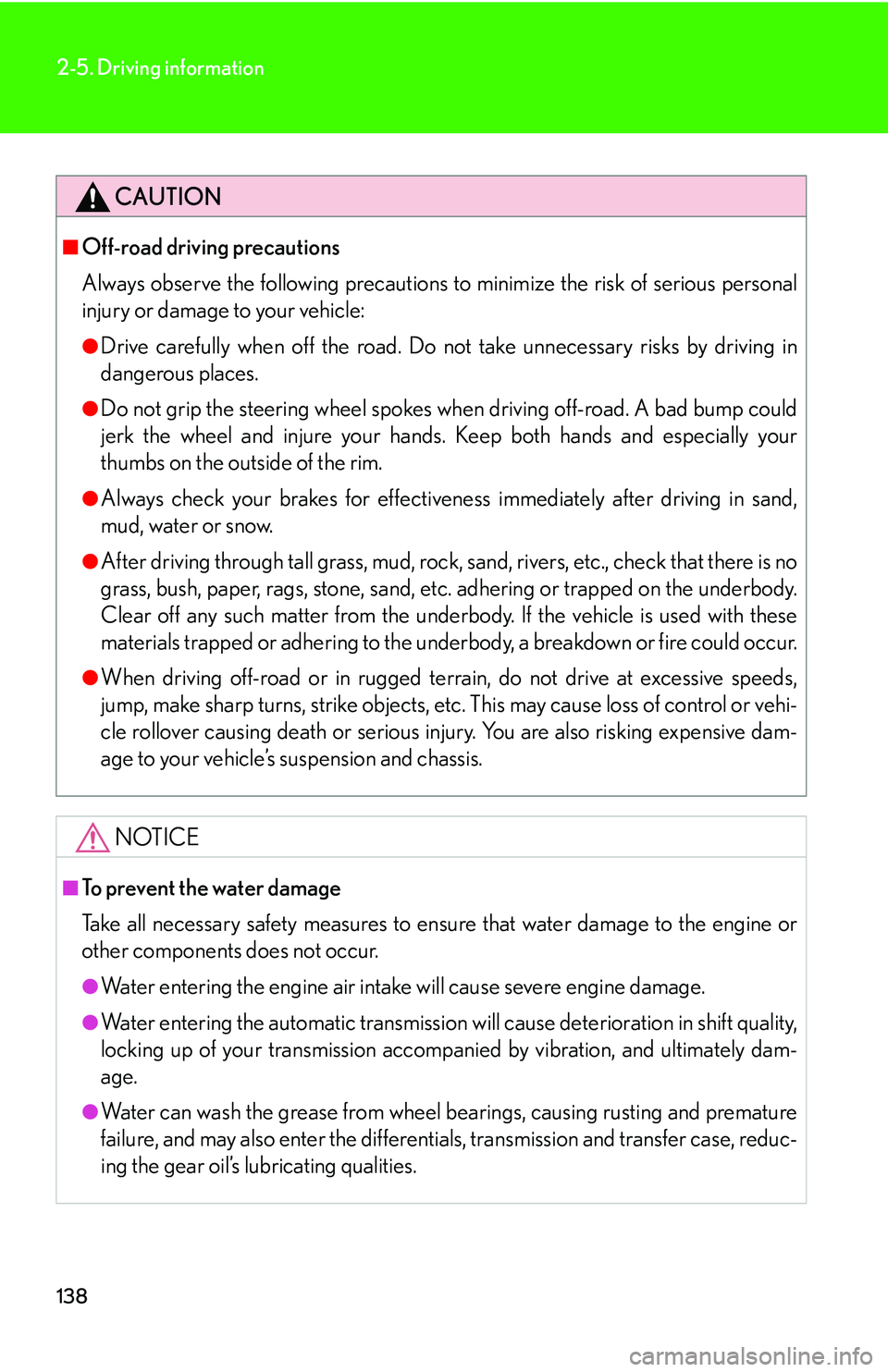
138
2-5. Driving information
CAUTION
■Off-road driving precautions
Always observe the following precautions to minimize the risk of serious personal
injury or damage to your vehicle:
●Drive carefully when off the road. Do not take unnecessary risks by driving in
dangerous places.
●Do not grip the steering wheel spokes wh en driving off-road. A bad bump could
jerk the wheel and injure your hands. Keep both hands and especially your
thumbs on the outside of the rim.
●Always check your brakes for effectiveness immediately after driving in sand,
mud, water or snow.
●After driving through tall grass, mud, rock, sand, rivers, etc., check that there is no
grass, bush, paper, rags, stone, sand, etc. adhering or trapped on the underbody.
Clear off any such matter from the underbody. If the vehicle is used with these
materials trapped or adhering to the underbody, a breakdown or fire could occur.
●When driving off-road or in rugged te rrain, do not drive at excessive speeds,
jump, make sharp turns, strike objects, etc. This may cause loss of control or vehi-
cle rollover causing death or serious injury. You are also risking expensive dam-
age to your vehicle’s suspension and chassis.
NOTICE
■To prevent the water damage
Take all necessary safety measures to ensure that water damage to the engine or
other components does not occur.
●Water entering the engine air intake will cause severe engine damage.
●Water entering the automatic transmission will cause deterioration in shift quality,
locking up of your transmission accompanied by vibration, and ultimately dam-
age.
●Water can wash the grease from wheel bearings, causing rusting and premature
failure, and may also enter the differentials, transmission and transfer case, reduc-
ing the gear oil’s lubricating qualities.
Page 174 of 436
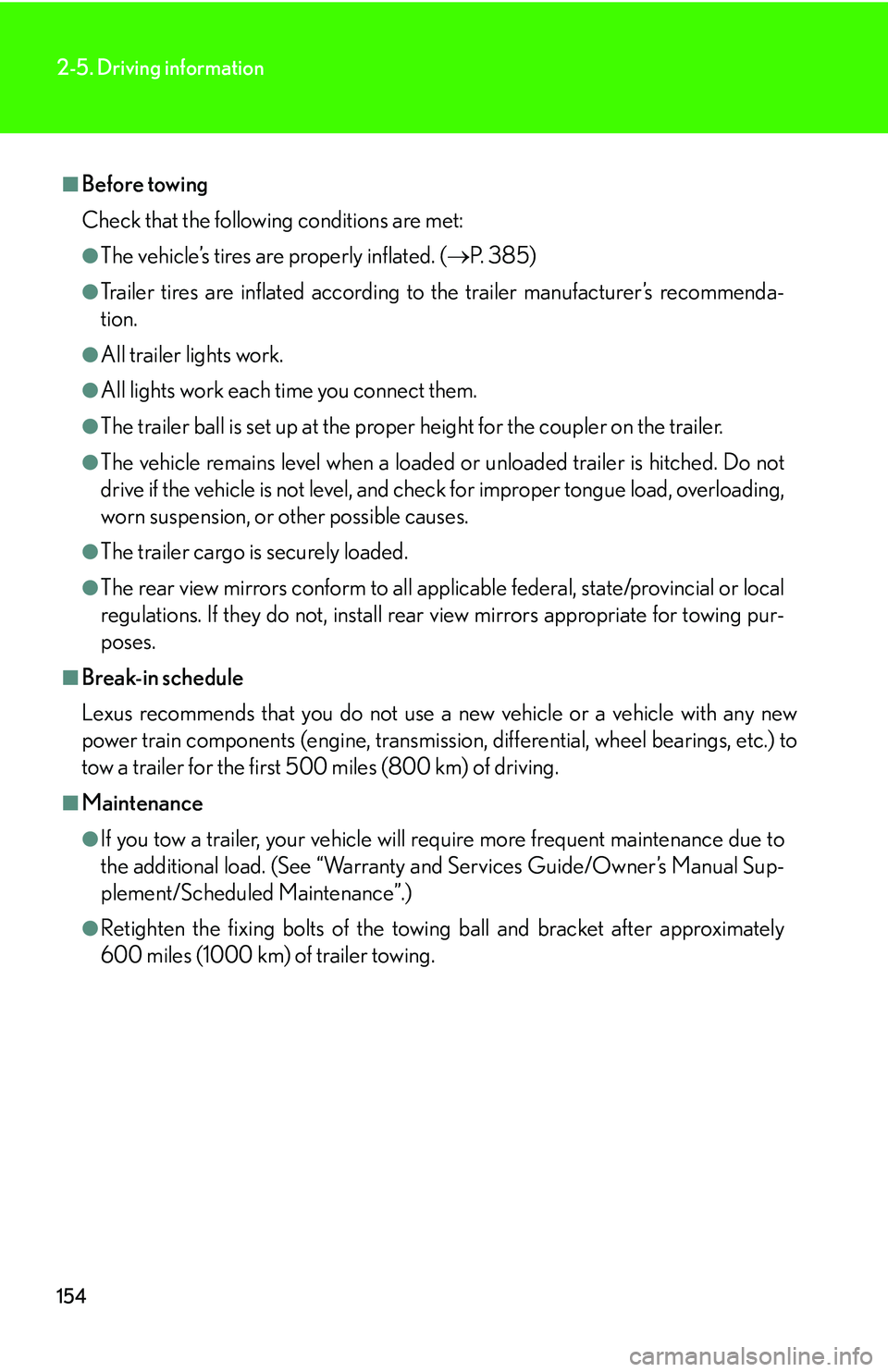
154
2-5. Driving information
■Before towing
Check that the following conditions are met:
●The vehicle’s tires are properly inflated. (P. 3 8 5 )
●Trailer tires are inflated according to the trailer manufacturer’s recommenda-
tion.
●All trailer lights work.
●All lights work each time you connect them.
●The trailer ball is set up at the proper height for the coupler on the trailer.
●The vehicle remains level when a loaded or unloaded trailer is hitched. Do not
drive if the vehicle is not level, and check for improper tongue load, overloading,
worn suspension, or other possible causes.
●The trailer cargo is securely loaded.
●The rear view mirrors conform to all applicable federal, state/provincial or local
regulations. If they do not, install rear view mirrors appropriate for towing pur-
poses.
■Break-in schedule
Lexus recommends that you do not use a new vehicle or a vehicle with any new
power train components (engine, transmission, differential, wheel bearings, etc.) to
tow a trailer for the first 500 miles (800 km) of driving.
■Maintenance
●If you tow a trailer, your vehicle will require more frequent maintenance due to
the additional load. (See “Warranty and Services Guide/Owner’s Manual Sup-
plement/Scheduled Maintenance”.)
●Retighten the fixing bolts of the towing ball and bracket after approximately
600 miles (1000 km) of trailer towing.
Page 395 of 436

5
When trouble arises
375
5-2. Steps to take in an emergency
If the vehicle becomes stuck
CAUTION
■When attempting to free a stuck vehicle
If you choose to rock the vehicle back and forth to free it, make sure the surround-
ing area is clear, to avoid striking other vehicles, objects or persons. The vehicle
may also lunge forward or lunge back suddenly as it becomes free. Use extreme
caution.
■When shifting the shift lever
Be careful not to shift the shift lever with the accelerator pedal depressed.
This may lead to unexpected rapid acceleration of the vehicle that may cause an
accident and result in death or serious injury.
NOTICE
■To avoid damaging the transmission and other components
●Avoid spinning the wheels and racing the engine.
●If the vehicle remains stuck after trying these procedures, the vehicle may require
towing to be freed.
Carry out the following procedures if the tires spin or the vehicle becomes
stuck in mud, dirt, or snow.
Stop the engine. Set the parking brake and shift the shift lever
to “P”.
Remove the mud, snow, or sand from around the stuck tire.
Place wood, large stones or so me other material to help pro-
vide traction under the tires.
Restart the engine.
Lock the center differential to turn off the vehicle stability con-
trol system. ( P. 121)
Carefully apply the accelerator to free the vehicle.STEP1
STEP2
STEP3
STEP4
STEP5
STEP6
Page 403 of 436
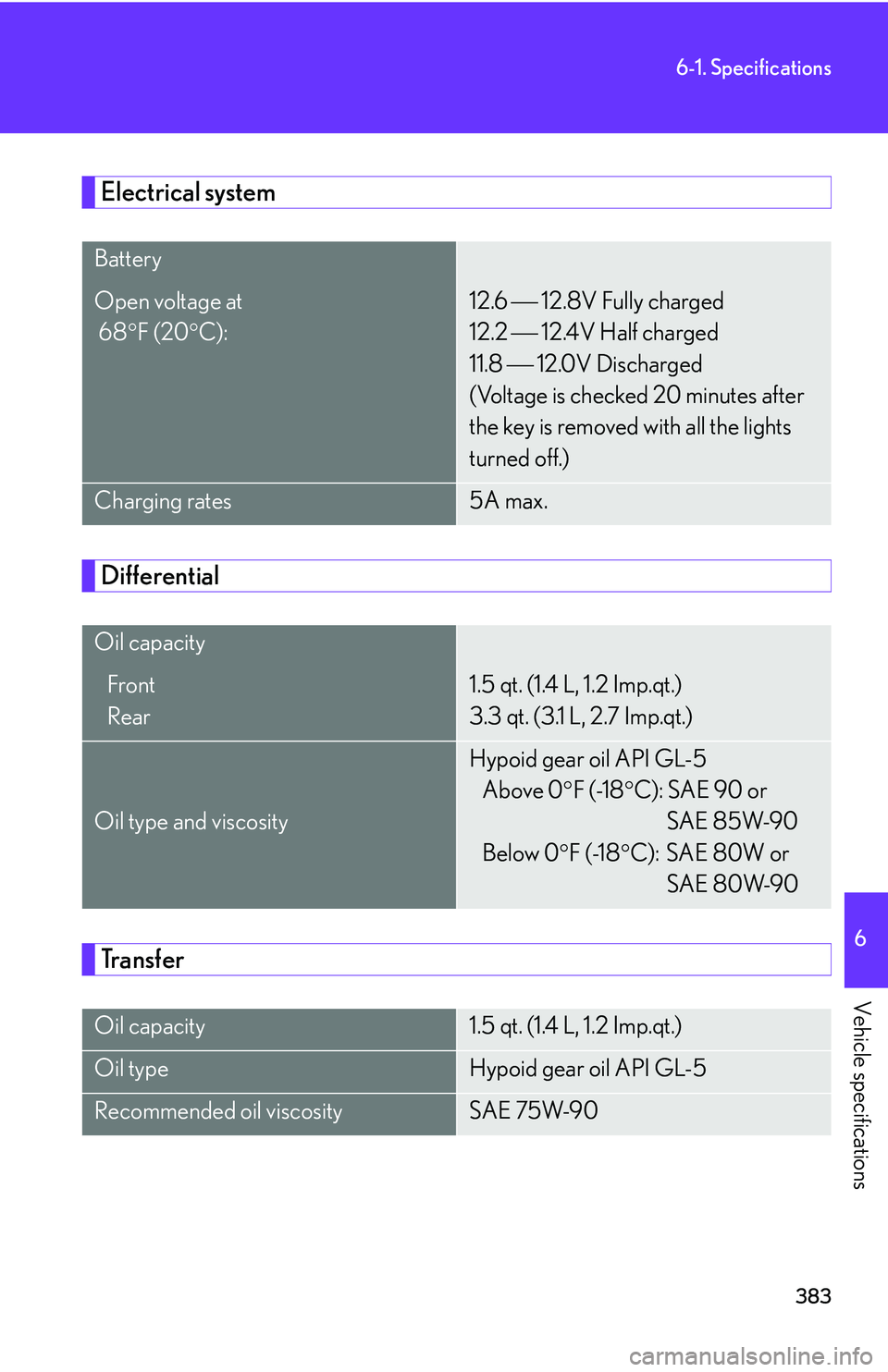
383
6-1. Specifications
6
Vehicle specifications
Electrical system
Differential
Tr a n s f e r
Battery
Open voltage at
68F (20 C):12.6 12.8V Fully charged
12.2 12.4V Half charged
11.8 12.0V Discharged
(Voltage is checked 20 minutes after
the key is removed with all the lights
turned off.)
Charging rates5A max.
Oil capacity
Front
Rear1.5 qt. (1.4 L, 1.2 Imp.qt.)
3.3 qt. (3.1 L, 2.7 Imp.qt.)
Oil type and viscosity
Hypoid gear oil API GL-5
Above 0 F (-18C): SAE 90 or
SAE 85W-90
Below 0 F (-18 C): SAE 80W or
SAE 80W-90
Oil capacity1.5 qt. (1.4 L, 1.2 Imp.qt.)
Oil typeHypoid gear oil API GL-5
Recommended oil viscositySAE 75W-90
Page 426 of 436
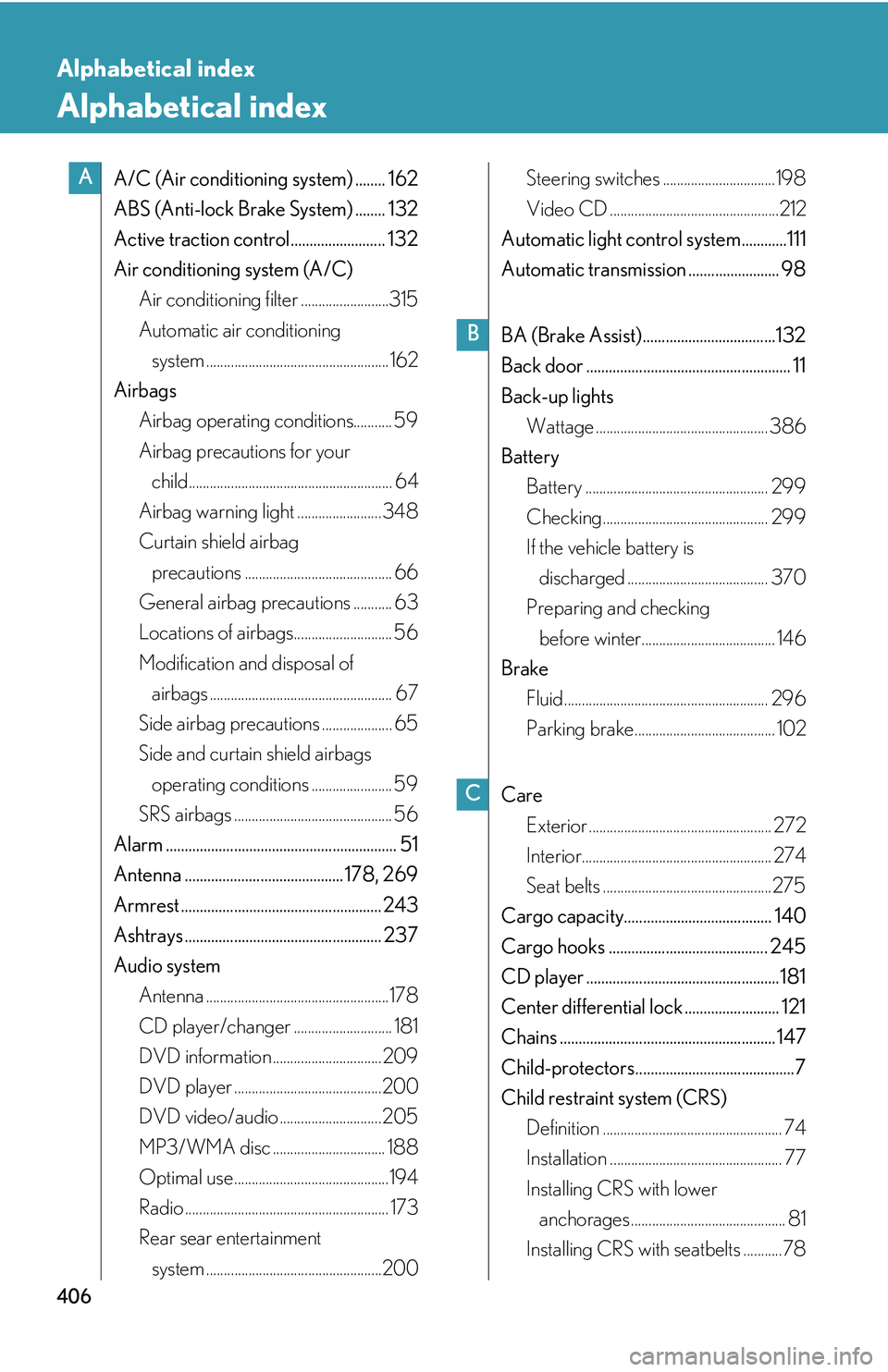
406
Alphabetical index
Alphabetical index
A/C (Air conditioning system) ........ 162
ABS (Anti-lock Brake System) ........ 132
Active traction control......................... 132
Air conditioning system (A/C)Air conditioning filter .........................315
Automatic air conditioning system .................................................... 162
Airbags Airbag operating conditions........... 59
Airbag precautions for your child.......................................................... 64
Airbag warning light ........................348
Curtain shield airbag precautions .......................................... 66
General airbag precautions ........... 63
Locations of airbags............................ 56
Modification and disposal of airbags .................................................... 67
Side airbag precautions .................... 65
Side and curtain shield airbags operating conditions ....................... 59
SRS airbags ............................................. 56
Alarm ............................................................. 51
Antenna .......................................... 178, 269
Armrest ..................................................... 243
Ashtrays .................................................... 237
Audio system Antenna ....................................................178
CD player/changer ............................ 181
DVD information ...............................209
DVD player ..........................................200
DVD video/audio .............................205
MP3/WMA disc ................................ 188
Optimal use............................................194
Radio .......................................................... 173
Rear sear entertainment system ..................................................200 Steering switches ................................198
Video CD ................................................212
Automatic light control system............111
Automatic transmission ........................ 98
BA (Brake Assist)...................................132
Back door ...................................................... 11
Back-up lights Wattage ................................................. 386
Battery Battery .................................................... 299
Checking............................................... 299
If the vehicle battery is discharged ........................................ 370
Preparing and checking before winter...................................... 146
Brake Fluid .......................................................... 296
Parking brake........................................ 102
Care Exterior .................................................... 272
Interior...................................................... 274
Seat belts ................................................275
Cargo capacity....................................... 140
Cargo hooks .......................................... 245
CD player ................................................... 181
Center differential lock ......................... 121
Chains ......................................................... 147
Child-protectors..........................................7
Child restraint system (CRS) Definition ................................................... 74
Installation ................................................. 77
Installing CRS with lower anchorages ............................................ 81
Installing CRS with seatbelts ...........78A
B
C